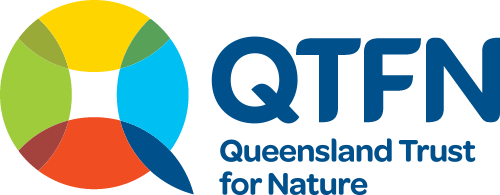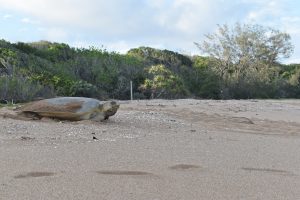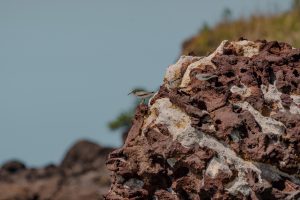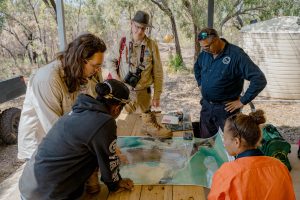Avoid Island Nature Refuge
An ecologically significant sanctuary
Avoid Island lies in the saltwaters of Koinmerburra Country, and is one of the only privately-owned and permanent nature refuges in the southern Great Barrier Reef. The island is managed by QTFN, in collaboration with our partners.
Avoid Island hosts a unique array of inshore species, a diverse range of threatened shorebirds, and an abundance of marine life. It is a key nesting site for the vulnerable east Australian population of Flatback Turtles (Natator depressus), that nest exclusively in Australia. Interestingly, Avoid Island has no ground-dwelling mammals; there are no feral animals and weeds are scarce. Vegetation on the island ranges from mangroves and grasslands to rainforests and estuarine wetland, with 16 hectares of the Critically Endangered Littoral Rainforest and Coastal Vine Thickets of Eastern Australia. Avoid Island has an impressive biodiversity given its 83-hectare size.
Make your impact
- QTFN is working with the Koinmerburra Aboriginal Corporation to develop a two-way land management plan for the island; we jointly conduct management field trips and jointly deliver education and threatened species outcomes as part of the Great Barrier Reef Foundation’s Reef Islands Initiative.
- QTFN and Koinmerburra Aboriginal Corporation staff undertook fire management and traditional land management practices in June 2023. The trip reintroduced fire as a land management tool, incorporating ecological and cultural considerations.
- In September 2023, Elders and rangers from Koinmerburra Aboriginal Corporation, QTFN, and affiliates visited Avoid Island. The trip involved several collaborative activities that worked towards multiple aims, ultimately all contributing towards the co-management of Avoid Island.
- Exploring Avoid Island’s biodiversity
- In April 2023, QTFN ecologists and experts surveyed the biodiversity of Avoid Island through a BioBlitz funded by the Reef Islands Initiative. 65 bird species were recorded, with 18 species recorded on the island for the first time. Over 80 invertebrate species, 12 reptile species, four microbat species, 20 vegetation communities were recorded.
- The Avoid Island Biodiversity iNaturalist Project collates ongoing biodiversity records for the island.
- Habitat monitoring and maintenance to provide a safe nesting area for Flatback Turtles and other species, including threatened shorebirds
- Thanks to QTFN Ecologists and volunteers from Mackay and District Turtle Watch, the late November and early December 2022 Flatback Turtle census on Avoid Island recorded 51 individual Flatback Turtles and 74 nests, with over 80% of the nests hatching when the team returned in February 2023.
- Funding from the Department of Environment and Science’s Community Sustainability Action grant supported eco-volunteering trips for manual weeding of Mossman River Grass (Cenchrus echinatus) and removal of marine debris. Regular maintenance helps improve turtle nesting habitat, marine species’ health, and dune ecosystem integrity. Over 11 days in September 2021, QTFN and Koinmerburra Aboriginal Corporation staff, alongside 10 volunteers, weeded over seven hectares of Mossman River Grass and collected over 20kg of marine debris to protect turtle nesting habitat.
Header photo by Jasmine Louise Photography
- QTFN is working with the Koinmerburra Aboriginal Corporation to develop a two-way land management plan for the island; we jointly conduct management field trips and jointly deliver education and threatened species outcomes as part of the Great Barrier Reef Foundation’s Reef Islands Initiative.
Avoid Island has an impressive biodiversity given its 83-hectare size.
- 20 different vegetation communities, ranging from mangroves and grasslands to rainforests and estuarine wetland, with 16 hectares of the Critically Endangered Littoral Rainforest and Coastal Vine Thickets of Eastern Australia. These vegetation communities are made up of at least 197 plant species.
- It is a key nesting site for the vulnerable east Australian population of Flatback Turtles (Natator depressus), that nest exclusively in Australia. The 2022-2023 Flatback Turtle census saw over 80% of the 74 recorded nests hatched in February 2023. Avoid Island is a safe haven with nesting beaches free from light pollution and minimal predators, giving hatchlings the best chance of survival before they reach the ocean.
- Surveys on the island have documented 111 bird species, including a range of threatened shorebirds.
- Over 80 invertebrate species, including 21 butterfly species.
- 12 reptile species, including the eastern snake-necked turtle
- <4 microbat species and black flying-foxes.
- Interestingly, Avoid Island has no ground-dwelling mammals. No recorded cane toads or other feral animals, and very few weeds.
The geology of Avoid Island provides a remarkable array of different rock types and modes of deposition.
From 2021 to 2024, projects on Avoid Island have been primarily funded through the Great Barrier Reef Foundation’s Reef Islands Initiative. They have supported on-island activities including the April, June, and September 2023 trips.
- The Reef Islands Initiative is establishing a network of climate change refuges by protecting critical habitats on Great Barrier Reef islands, including Avoid Island. The 10-year program is an initiative of the Great Barrier Reef Foundation, supported by funding from Lendlease, the Australian Government’s Reef Trust, the Queensland Government and the Fitzgerald Family Foundation. In 2021, Avoid Island became the third Reef Islands Initiative site to support capacity building for island co-management between QTFN and Koinmerburra Aboriginal Corporation.
- QTFN has been working with the Koinmerburra Aboriginal Corporation to develop a two-way land management plan for the island and jointly deliver education and threatened species outcomes as part of the Great Barrier Reef Foundation’s Reef Islands Initiative.
- Wonder of Science has been creating educational materials for students around Avoid Island over the last 3 years, in collaboration with QTFN and Koinmerburra Aboriginal Corporation. Over three years until 2019, Wonder of Science partnered with QTFN to provide year nine students the opportunity to assist in data collection on Flatback Turtles on Avoid Island.
- Mackay and District Turtle Watch volunteers have helped the QTFN Ecologists collect nesting and hatchling data for Flatback Turtles during the annual census, with monitoring possible through external funding.
- External experts have also visited Avoid Island for the 2023 BioBlitz and other information gathering events, recording valuable knowledge about birds, invertebrates, reptiles, microbats, vegetation communities, and the geology of Avoid Island.
- In the 2021 to 2022 financial year, the Queensland Government Community Sustainability Action grant supported two volunteer trips for manual weeding of Mossman River Grass (Cenchrus echinatus) and removal of marine debris.
Action & Insight
QTFN and Koinmerburra Aboriginal Corporation knowledge sharing workshop
Michael Tervo, one of our QTFN Ecologists, joined Koinmerburra Aboriginal Corporation (KAC) this month for a skill-building and knowledge sharing workshop on ecological monitoring and evaluation techniques. During the workshop they refined ecological monitoring techniques, such as protocols and uses for photo monitoring points and drone mapping. The workshop also included a refresher on plant […]
A Turtle Sanctuary at Avoid Island
Over each summer from November to March, it’s turtle season at our Avoid Island Nature Refuge. Avoid Island is located 100 km southeast of Mackay, in the salt waters of Koinmerburra Country. As one of the three largest Flatback turtle (Natator depressus) rookeries in the southern Great Barrier Reef, our team aim to survey and […]
Avoid Island Hits 90 Bird Species
The Queensland’s Trust for Nature’s Long Term holdings property, Avoid Island, recently hit an important milestone: our bird list officially hit 90 species. Our team conduct regular maintenance, research and educational trips throughout the year to this privately owned and protected island and all bird sightings are recorded and documented as part of regular surveying. It […]
Impact Projects
- QTFN is working with the Koinmerburra Aboriginal Corporation to develop a two-way land management plan for the island; we jointly conduct management field trips and jointly deliver education and threatened species outcomes as part of the Great Barrier Reef Foundation’s Reef Islands Initiative.
- QTFN and Koinmerburra Aboriginal Corporation staff undertook fire management and traditional land management practices in June 2023. The trip reintroduced fire as a land management tool, incorporating ecological and cultural considerations.
- In September 2023, Elders and rangers from Koinmerburra Aboriginal Corporation, QTFN, and affiliates visited Avoid Island. The trip involved several collaborative activities that worked towards multiple aims, ultimately all contributing towards the co-management of Avoid Island.
- Exploring Avoid Island’s biodiversity
- In April 2023, QTFN ecologists and experts surveyed the biodiversity of Avoid Island through a BioBlitz funded by the Reef Islands Initiative. 65 bird species were recorded, with 18 species recorded on the island for the first time. Over 80 invertebrate species, 12 reptile species, four microbat species, 20 vegetation communities were recorded.
- The Avoid Island Biodiversity iNaturalist Project collates ongoing biodiversity records for the island.
- Habitat monitoring and maintenance to provide a safe nesting area for Flatback Turtles and other species, including threatened shorebirds
- Thanks to QTFN Ecologists and volunteers from Mackay and District Turtle Watch, the late November and early December 2022 Flatback Turtle census on Avoid Island recorded 51 individual Flatback Turtles and 74 nests, with over 80% of the nests hatching when the team returned in February 2023.
- Funding from the Department of Environment and Science’s Community Sustainability Action grant supported eco-volunteering trips for manual weeding of Mossman River Grass (Cenchrus echinatus) and removal of marine debris. Regular maintenance helps improve turtle nesting habitat, marine species’ health, and dune ecosystem integrity. Over 11 days in September 2021, QTFN and Koinmerburra Aboriginal Corporation staff, alongside 10 volunteers, weeded over seven hectares of Mossman River Grass and collected over 20kg of marine debris to protect turtle nesting habitat.
Header photo by Jasmine Louise Photography
About Avoid Island
Avoid Island has an impressive biodiversity given its 83-hectare size.
- 20 different vegetation communities, ranging from mangroves and grasslands to rainforests and estuarine wetland, with 16 hectares of the Critically Endangered Littoral Rainforest and Coastal Vine Thickets of Eastern Australia. These vegetation communities are made up of at least 197 plant species.
- It is a key nesting site for the vulnerable east Australian population of Flatback Turtles (Natator depressus), that nest exclusively in Australia. The 2022-2023 Flatback Turtle census saw over 80% of the 74 recorded nests hatched in February 2023. Avoid Island is a safe haven with nesting beaches free from light pollution and minimal predators, giving hatchlings the best chance of survival before they reach the ocean.
- Surveys on the island have documented 111 bird species, including a range of threatened shorebirds.
- Over 80 invertebrate species, including 21 butterfly species.
- 12 reptile species, including the eastern snake-necked turtle
- <4 microbat species and black flying-foxes.
- Interestingly, Avoid Island has no ground-dwelling mammals. No recorded cane toads or other feral animals, and very few weeds.
The geology of Avoid Island provides a remarkable array of different rock types and modes of deposition.
Who’s involved?
From 2021 to 2024, projects on Avoid Island have been primarily funded through the Great Barrier Reef Foundation’s Reef Islands Initiative. They have supported on-island activities including the April, June, and September 2023 trips.
- The Reef Islands Initiative is establishing a network of climate change refuges by protecting critical habitats on Great Barrier Reef islands, including Avoid Island. The 10-year program is an initiative of the Great Barrier Reef Foundation, supported by funding from Lendlease, the Australian Government’s Reef Trust, the Queensland Government and the Fitzgerald Family Foundation. In 2021, Avoid Island became the third Reef Islands Initiative site to support capacity building for island co-management between QTFN and Koinmerburra Aboriginal Corporation.
- QTFN has been working with the Koinmerburra Aboriginal Corporation to develop a two-way land management plan for the island and jointly deliver education and threatened species outcomes as part of the Great Barrier Reef Foundation’s Reef Islands Initiative.
- Wonder of Science has been creating educational materials for students around Avoid Island over the last 3 years, in collaboration with QTFN and Koinmerburra Aboriginal Corporation. Over three years until 2019, Wonder of Science partnered with QTFN to provide year nine students the opportunity to assist in data collection on Flatback Turtles on Avoid Island.
- Mackay and District Turtle Watch volunteers have helped the QTFN Ecologists collect nesting and hatchling data for Flatback Turtles during the annual census, with monitoring possible through external funding.
- External experts have also visited Avoid Island for the 2023 BioBlitz and other information gathering events, recording valuable knowledge about birds, invertebrates, reptiles, microbats, vegetation communities, and the geology of Avoid Island.
- In the 2021 to 2022 financial year, the Queensland Government Community Sustainability Action grant supported two volunteer trips for manual weeding of Mossman River Grass (Cenchrus echinatus) and removal of marine debris.
Action & insight
Action & Insight
QTFN and Koinmerburra Aboriginal Corporation knowledge sharing workshop
Michael Tervo, one of our QTFN Ecologists, joined Koinmerburra Aboriginal Corporation (KAC) this month for a skill-building and knowledge sharing workshop on ecological monitoring and evaluation techniques. During the workshop they refined ecological monitoring techniques, such as protocols and uses for photo monitoring points and drone mapping. The workshop also included a refresher on plant […]
A Turtle Sanctuary at Avoid Island
Over each summer from November to March, it’s turtle season at our Avoid Island Nature Refuge. Avoid Island is located 100 km southeast of Mackay, in the salt waters of Koinmerburra Country. As one of the three largest Flatback turtle (Natator depressus) rookeries in the southern Great Barrier Reef, our team aim to survey and […]
Avoid Island Hits 90 Bird Species
The Queensland’s Trust for Nature’s Long Term holdings property, Avoid Island, recently hit an important milestone: our bird list officially hit 90 species. Our team conduct regular maintenance, research and educational trips throughout the year to this privately owned and protected island and all bird sightings are recorded and documented as part of regular surveying. It […]




